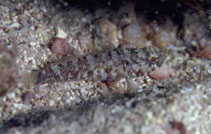| Family: |
Gobiidae (Gobies), subfamily: Gobiinae |
| Max. size: |
6.75 cm TL (male/unsexed) |
| Environment: |
demersal; marine; depth range - 11 m |
| Distribution: |
Eastern Central Atlantic: known only from Cape Verde. |
| Diagnosis: |
Dorsal spines (total): 7-7; Dorsal soft rays (total): 12-12; Anal spines: 1-1; Anal soft rays: 10-10. Anterior nostril with long multifid tentacle, posterior nostril pore-like; angle of jaws below anterior edge of pupil; upper lip width equal to that of preorbital width; teeth caniniform, in three or four rows medially (Ref. 39517). It appears close to Gobius ater, but it has a higher number of pectoral fin rays (22), fewer anal branched rays (10), a lower mode for second dorsal branched rays (12) and modally fewer scales in lateral series (Ref. 39517). Body is more or less uniform brown with numerous small black marks along lateral midline on most scales (Ref.39517). |
| Biology: |
Found from tide pool to 11m, on sand, stones and rock substrata (Ref. 39517). |
| IUCN Red List Status: |
Least Concern (LC); Date assessed: 17 April 2015 Ref. (130435)
|
| Threat to humans: |
harmless |
Source and more info: www.fishbase.org. For personal, classroom, and other internal use only. Not for publication.
